Welcome Home? Syrian Refugees Building On Top of History
I recently returned from visiting Syrian refugees in northern Iraq and Jordan on a field mission with Refugees International. As I handed over my passport and custom’s form to the U.S. officer, he said: “Welcome home!”
That greeting always touches me but more than ever after this trip spending time with refugees who have no idea when and if they might be able to go home, who no longer know where their home is. Hundreds of thousands are living in tents and caravans and many in even more problematic structures in fields and behind houses across the border from Syria. Men, women and children–often on foot or in buses and taxis–have fled into Iraq, Jordan, Lebanon, Turkey and countries further away.
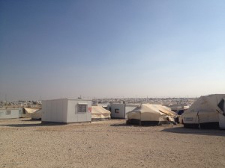
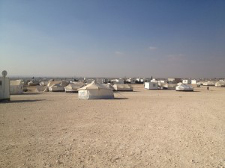
The displacement from the three-year old civil war in Syria has caused the worst refugee crisis since Rwanda, according to officials at the United Nations High Commission on Refugees (UNHCR). They estimate that at least two million people have fled across Syria’s borders and millions more are internally displaced. Adding to the challenge of assisting these people are the growing restrictions on crossing from Syria into Iraq and Jordan, restrictions which some complain are tantamount to closing the borders.
In Jordan, a country of six million people, the UNHCR believes that there are nearing 600,000 refugees, and some others estimate the figure to be over a million. In both Iraq and Jordan, only a third of the refugees are in camps; the rest are dispersed throughout cities and towns, often unregistered and without services.
“We walked three days in the dark, at night, afraid, carrying our two children,” said one young man, who travelled with his wife and three-year old son and one-year old daughter, trying to avoid the fighting. They finally got a ride and arrived at Za’atari refugee camp in the desert of northern Jordan. The Za’atari camp, originally built for 10,000 people, currently houses over 80,000 and at times has held as many as 150,000. The camp is now the fourth largest “city” in Jordan.
Though conditions have improved considerably, according to those who have visited the camp in the past, the landscape at Za’atari is stark—five square miles of barren rocky desert with tents and caravans laid out as far as the eye can see. There is not a single tree or bush or plant anywhere, nothing to break the view except coiled barbed wire around certain parts of the compounds. Running through the middle of the acres of desert is a dusty path with stalls on either side where residents sell vegetables, clothes, shoes and other wares. The residents have dubbed it the Champs Élysées. A new camp nearby has been set up and will soon take the overflow from Za’atari.
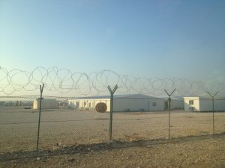
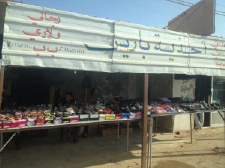
The conflict in Syria is only eight miles away. According to one humanitarian aid worker, you can sometimes hear the explosions. The proximity to the border and the conflict adds to the insecurity in the camp.
“Za’atari is the tip of the iceberg of the Syrian crisis,” said Kilian Kleinschmidt, the camp manager.
Za’atari is said to be the second largest refugee camp in the world. Since Kleinschmidt arrived in March, the violence in the camp has decreased, but there is still considerable resistance to authority, he says. “The challenge is for the people to respect some authority so when the refugees return, they can rebuild and govern Syria. If people return with the state of mind now, it is going to be difficult.”
In the past months the camp has been divided into 12 districts. The UNHCR camp manager is planning for everyone to be registered with an address so each refugee can be located. Another goal is to replace tents with metal caravans, which offer more protection from the elements.
“People want to be able to stand upright in their homes and be able to lock their door at night,” Kleinschmidt said. But the caravans promised by international donors are no longer arriving in the numbers needed.
The camp is preparing for winter. Ninety thousand thermal blankets had just arrived, and winterization packages were being assembled which would also include plastic sheeting, kerosene and heaters. A few days before 20,000 ration cards had been deactivated in an attempt to get an accurate registration roster. A large protest had broken out, including among those whose ration cards no longer worked.
Education for the children is a significant challenge in Za’atari and at other refugee camps as well as among those living out in the Jordanian communities. In Za’atari an estimated 13,000 children attend school out of 18,000 enrolled and an estimated 55,000 youth in total. Outside the camps parents often face fees and expenses for schools. One parent living in a community outside the camp said he wanted to send his children to school, but he didn’t have the funds, and he was not allowed to work to earn the money. In Syria he had been a school principal.
As the year ends, the region is facing increasing needs and another shortfall of funds, according to Daryl Grisgraber, senior advocate for Refugees International. (Running Za’atari is said to cost roughly $500,000/day.) But there is also some progress with more countries willing to take in Syrian refugees on humanitarian grounds.
Despite the harsh conditions in Za’atari, there are signs of hope. Myriad small enterprises—30 restaurants, a supermarket, even a new coffee shop—have sprung up. There are many more births (10 per day) than deaths (5 per week).
The situation in northern Iraq appears less tense than in Jordan, perhaps because both the refugees and the residents are Kurdish.

At a local community-based organization in Sulaymaniyah one worker noted, “There is a bond between us. The Syrians Kurds took us in at a time we needed help. Now we can help them.”
The staging areas for urban refugees who come to Sulaymaniyah for assistance is a former military barracks where Saddam Hussein’s army tortured Kurdish citizens in an underground chamber. The conversion of the barracks and torture chambers into a community center was financed by a grant from the U.S. government which is reported to have contributed $1 billion to the Syrian refugee crisis. Now refugees gather in the former barracks to get assistance with housing, food and education. In Northern Iraq the refugees are given six-month residence permits that are renewable, and a new program has just commenced offering 70- four-year university scholarships to refugees who have competed and qualified for the slots.
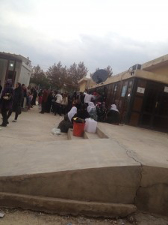
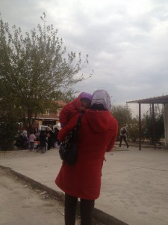
“Our home was bombed. Though we lived just four miles from the Turkish border, we came here because for us the language is better and the people know us. In the war of ’91 the Syrian people helped the people here,” said one father of two. He has pitched a tent in a field where he helps on the farm, though when the farming season is over, he doesn’t know where he and his family will live.
Not just giving the refugees the opportunity to survive this terrible time, but offering 70 four-year university scholarships–that is truly inspiring!
Thank you, Joanne for reporting on the seriousness of this situation. I found your article inspiring and very humbling. Most Americans do not realize how fortunate they really are. Also, thank you Kamber, (my beautiful daughter) for bringing this story to so many people. For, that is how soicial media should be used.
It is so hard to fathom daily life for these people. It is really tragic. The most tragic reality is that by making a decision to protect your family from harm, you essentially have to sacrifice everything else. The goal of making these camps temporary and relocating families to a more permanent setting seems key. Is that part of the effort? How can we help and bring awareness to the harsh daily realities of these refugees?
The challenge is that this crisis is still under many people’s radar and the conflict in Syria has no easy answer. The big answer is to stop the violence, but that is complicated. There are organizations and NGOs working on behalf of the refugees, but support, especially governmental, is limited and most countries don’t want any more refugees. Most of the Syrians would like to return home, but not until the violence stops.
What a bleak situation you found at the Jordanian refugee camp. I know it helps to have the light shine on the conditions. It’s encouraging to see how the refugees are beginning to organize themselves and that other countries are beginning to help. Thanks for your insights on what has seemed a remote and puzzling tragedy. It does remind us of how much we have to be thankful for.
I appreciated your insights on a lot of issues, not only the overall level of suffering and despair, but some of the other tragedies like the education deficit in the camps. Only 13,000 of the 55,000 children in school – a generation lost. And I had not heard the statistic before – 10 births for every 5 deaths. Imagine what the camp will be like in a few years. Killian Kleinschmidt is an old friend (he had been in Pakistan for a number of years). I too had been in Za’atria, went up last June to spend a day with him. We will have to compare notes.
–Maureen White, Visiting Scholar Johns Hopkins SAIS Human Security Initiative
I am so moved that I can hardly express my feelings. How do people continue to live like this?
Every time I hear “what should I buy my child for Christmas” I think of these sad children growing up in a desolate camp without anything. I know life isn’t always fair, but this situation is far beyond fair.
I pray that somehow something will change for these people.
We all learn from your story-telling, insights, and context-providing. If you are aware of organizations addressing the needs of these refugees, you might want to list them and/or provide links so those who want to take some action can.
There are a number of organizations helping with direct assistance, including Save the Children (http://www.savethechildren.org), the International Rescue Committee (http://www.rescue.org/), CARE (http://www.care.org/), and of course UNHCR (the United Nations High Commission on Refugees – http://www.unhcr.org) as well as advocacy being done on behalf of the refugees by Refugees International (http://www.refintl.org/), Human Rights Watch (http://www.hrw.org/) and others.
thanks a lot dear Joanne
sometimes we forget…in the hustle bustle of life….great piece of information
chiara